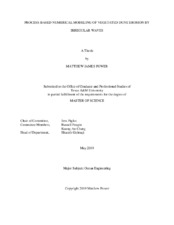| dc.description.abstract | Coastlines often have to be maintained through engineering practices to preserve coastal communities and environments and to limit damage from flooding during storm impact. As the expenses of coastal upkeep increase due to increasing near-shore human populations and climate change, cheaper and more environmentally conscious options are preferred. Vegetated dunes can provide such an option, whether naturally occurring, or engineered. The proper use of vegetation has been shown to reduce rates of dune erosion during wave impact. Unfortunately, information regarding vegetated dune application is sparse and quantification of the benefits of various vegetation strategies for erosion reduction is still limited. Morphodynamic changes of coastal profiles including sand dunes resulting from hydrodynamic forcing are usually simulated via process-based numerical models to assess beach nourishment and dune restoration design options. However, many of these models need to incorporate the vegetation effect on erosion in a simplified process parameterization which requires calibration with field and laboratory data. The proposed work investigates the potential of the open-source 1D cross-shore depthaveraged morphodynamic model CSHORE to simulate erosion of vegetated dunes during elevated storm water levels and irregular wave impact. This was accomplished by adjusting various CSHORE parameters such as the spatially-varying bed friction factor and the substrate angle of repose, to match beach and dune profile evolution and hydrodynamic data obtained from a smallscale physical model wave flume experiment conducted with real sand and real vegetation (4 different morphotypes). The effect vegetation characteristics have on erosion and nearshore hydrodynamics will also be evaluated.
Results show that CSHORE is capable of simulating vegetated dune profile evolution during wave-induced erosion to some extent by adjusting model parameters, but it also becomes evident that a new subroutine specifically addressing the aboveground and belowground aspects of vegetation on dune erosion will be a necessary future model update. However, the extent of representing vegetation strictly as friction coefficients within CSHORE is bleak. On the other hand, the numerical model responded more appropriately to the inclusion of vegetation when the angle of repose was varied instead, indicating that higher vegetation characteristics (i.e. aboveground surface area, fine root mass, coarse root mass, stem rotational stiffness, and mycorrhizal population) can likely be represented as higher angles of repose within the dune area. Results from this thesis could assist in providing more cost-effective engineering guidelines for coastal engineers looking for ways to incorporate vegetated dune systems into their coastal protection strategies. | en |


